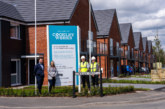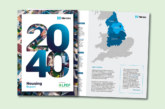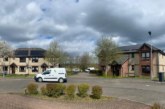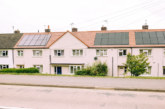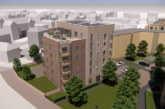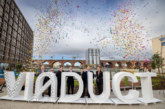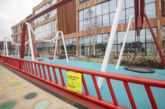The first completed section of Southampton City Council’s redevelopment of Townhill Park has been celebrated with ringing endorsements of the scheme’s energy-efficient features and sustainable design.
Six new three-bedroom houses, plus a block of 50 flats containing a mixture of one-bedroom, two-bedroom and three-bedroom homes, have recently been completed, with the council working with building contractor Drew Smith Group.
The Townhill Park redevelopment boasts impressive environmental credentials, which not only support the council’s green agenda — and its newly launched Green City Charter — but will also ultimately have a positive impact on residents’ energy bills.
As a whole, the project has delivered very positive CO2 Emission and Energy Efficiency ratings, which are up to 19.07% better than the government targets**.
Councillor Steve Leggett, Cabinet Member for Green City and Environment, said: “We’re delighted to have delivered this impressive development, which not only provides quality accommodation for our residents, but also has strong environmental credentials. We’re proud to have installed solar panels, a green roof and energy-efficient heating systems. It’s great that all residents are also supplied with competitively priced green electricity from the offset through CitizEn Energy.
“This project highlights the council’s commitment to prioritising the green agenda and helping to make Southampton a cleaner, greener and healthier city for all.”
The flats benefit from:
- 104 Photovoltaic (PV) (solar) panels installed on the roof of the block. This power will be used in the communal area’s power and lighting circuitry. The energy saved from these panels is the equivalent of leaving a 42” television running continuously for 15 years.
- Energy-efficient heating systems. The communal gas fire boiler system has a seasonal efficiency of 95.9%, which supplies water heated to a nominal temperature of 55˚ Celsius to each home through a network of flow-and-return mechanical pipework. Any heat loss from this pipework is used to heat the communal areas of the building.
- Heat Interface Units (HIU). These use the heated water from the communal boilers to regulate the temperature of domestic cold water to the desired temperature of the occupier for washing and bathing.
- Regulated heating. The heated water from the communal boilers is also regulated for domestic space heating within each flat. Having a single bulk gas supply to the communal boilers gives Southampton City Council the opportunity to negotiate a preferential rate with the gas supplier that can be passed onto tenants.
- A green roof on the fourth floor of the block. This improves the fabric energy efficiency of the building by moderating heat flow through a building by shading, increased insulation and thermal mass. Green roofs provide potential energy savings by improving building insulation characteristics.
- CitizEn Energy, an ethical energy provider set up by Southampton City
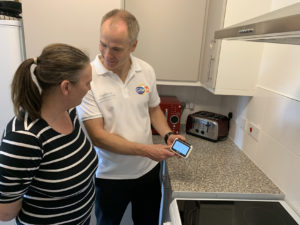 Council. This offers residents competitively priced gas and green electricity*, along with a smart meter to help manage their energy, from day one of move in. CitizEn Energy recently celebrated reaching a milestone 1,500 customers, and any profit they make goes straight back into projects to help improve the lives of the people within the local community. CitizEn Energy works with not-for-profit organisations to offer eligible customers grants to help to improve the energy efficiency of their home. In addition, CitizEn Energy voluntarily signed up to Warm Home Discount, which means customers who are getting Pension Credit, or are a low-income household, could qualify for this one-off discount of £140 on their energy bill. This all helps to make homes warmer, more comfortable and cheaper to run.
Council. This offers residents competitively priced gas and green electricity*, along with a smart meter to help manage their energy, from day one of move in. CitizEn Energy recently celebrated reaching a milestone 1,500 customers, and any profit they make goes straight back into projects to help improve the lives of the people within the local community. CitizEn Energy works with not-for-profit organisations to offer eligible customers grants to help to improve the energy efficiency of their home. In addition, CitizEn Energy voluntarily signed up to Warm Home Discount, which means customers who are getting Pension Credit, or are a low-income household, could qualify for this one-off discount of £140 on their energy bill. This all helps to make homes warmer, more comfortable and cheaper to run.
Over the next eight years, 665 new, quality flats and houses are set to be built at Townhill Park — an important part of the council’s commitment to providing more affordable council homes in Southampton.
Plans for the new-look estate also include environmental improvements to Frogs Copse, improved pedestrian and cycling paths, traffic calming of Meggeson Avenue, a new community space — or ‘Village Green’ — featuring outdoor meeting space and play facilities, a new convenience store and, potentially, a café.
Councillor Satvir Kaur, Cabinet Member for Homes and Culture, said: “Southampton City Council is committed to delivering more affordable council-owned homes, and it’s essential these homes are also of quality and affordable to run as well. The regeneration of Townhill Park is underway and is a great example of how the council is going the extra mile to deliver sustainable homes, with high-tech energy-efficiency measures in every property. I hope residents will be very happy living here and I’m looking forward to welcoming more new residents as the Townhill Park redevelopment moves forward.”
Leanne Smith, New Business Director, Drew Smith Group, commented: “We are very proud to have delivered new housing of this calibre which included such an emphasis on the environment and social responsibility. We hope that all residents enjoy their new homes and the features that will contribute to a greener future.”
Header image Pictured right to left: Leanne Smith (New Business Director, Drew Smith Group), Sue Jones (Housing Department, Southampton City Council), Jason Taylor (Energy Manager, Southampton City Council), Councillor Steve Leggett (Cabinet Member for Green City and Environment, Southampton City Council), Rachel Watson (resident at Townhill Park), Councillor Satvir Kaur (Cabinet Member for Homes and Culture at Southampton City Council), Peter Cooper (Drew Smith Group).
*Our green electricity tariffs are certified as being sourced from UK based wind and solar generators. For every Megawatt hour (MWh) of electricity purchased for our customers, we also purchase a Renewable Energy Guarantee of Origin (REGO) certificate, which proves the electricity is certified as being sourced either directly from the renewable generators or through a green wholesale energy provider.
**As a whole the project has delivered a Dwelling CO2 Emission Rate (DER), which is 19.07% better than the Target CO2 Emission Rates (TER). The building also has a Dwelling Fabric Energy Efficiency (DFEE), which is 17.24% better than the Target Fabric Energy Efficiency Rates set out by the secretary of state within Building Regulations Approved Document Part L. DER/TER improvements will save the occupiers on average £74.03 (41%) per year on their energy bills, when compared to a system that meets Building Regulation requirements.



